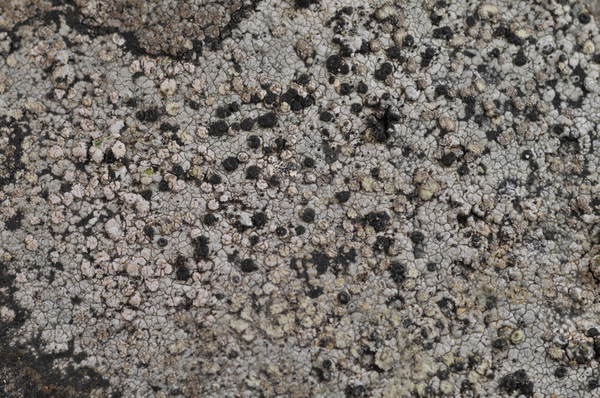Porpidia soredizodes (Lamy) J.R. Laundon
Bot. J. Linn. Soc., 101: 104, 1989. Basionym: Lecidea meiospora var. soredizodes Lamy - Bull. Soc. Bot. Fr., 30: 410, 1883.
Synonyms: Haplocarpon soredizodes (Lamy) V. Wirth; Huilia soredizodes (Lamy) Hertel; Lecidea soredizodes (Lamy) Sandst. non (Nyl.) Vain.
Distribution: N - TAA.
Description: Thallus crustose, endosubstratic to thinly episubstratic, usually forming small patches, pale to dark grey or olive-grey, sometimes partially rust-red, smooth and subcontinuous to rimose-areolate, sorediate, often delimited by a dark brown prothallus. Medulla white, I-. Soralia scattered, rounded to irregular white, pale grey or greenish, usually excavate, 0.2-0.5 mm in diam., the soredia farinose to granular. Apothecia very rare, lecideine, immersed to sessile, 0.3-0.7(-1.8) mm across, with a dark brown (when wet) to black, epruinose, flat disc and a thick, black, raised proper margin. Proper exciple dark brown to black, the hyphae 4-7 μm thick; epithecium brownish to olive, N+ orange, K-; hymenium colourless, (65-)80-120(-160) μm high; paraphyses coherent, branched and anastomosing, slightly swollen at tips; hypothecium dark brown. Asci 8-spored, elongate-clavate, with a thin, outer amyloid layer and a thickened tholus penetrated by a pore, the sides of which are strongly amyloid, Porpidia-type. Ascospores 1-celled, hyaline, ellipsoid, (10-)13-19(-22) x (4-)6-10 µm. Photobiont chlorococcoid. Spot tests: soralia K+ pale yellow or rarely K-, C-, KC-, P+ orange or rarely P-, UV-. Chemistry: stictic acid, sometimes with traces of cryptostictic acid, or rarely without lichen substances. Note: a cool-temperate to boreal-montane lichen found on siliceous rocks in forests, gorges, and on north-exposed faces of large siliceous boulders, mostly in upland areas but not reaching beyond treeline.
Growth form: Crustose
Substrata: rocks
Photobiont: green algae other than Trentepohlia
Reproductive strategy: mainly asexual, by soredia, or soredia-like structures (e.g. blastidia)
Most common in areas with a humid-warm climate (e.g. most of Tyrrenian Italy)
Commonnes-rarity: (info)
Alpine belt: absent
Subalpine belt: extremely rare
Oromediterranean belt: absent
Montane belt: very rare
Submediterranean belt: absent
Padanian area: absent
Humid submediterranean belt: absent
Humid mediterranean belt: absent
Dry mediterranean belt: absent
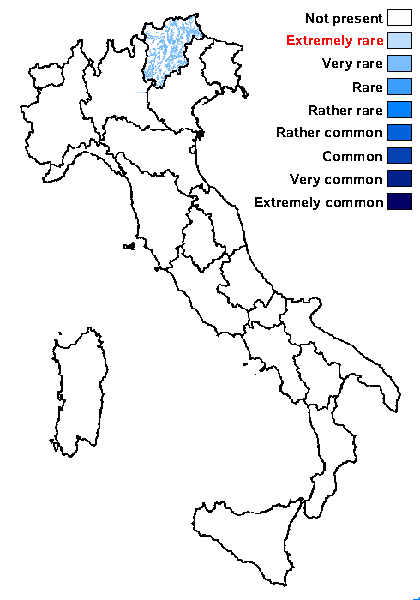
Predictive model

Bernard Bouffinier - Source: http://www.lichensmaritimes.org/index.php?task=fiche&lichen=419&lang=en
France, Cast
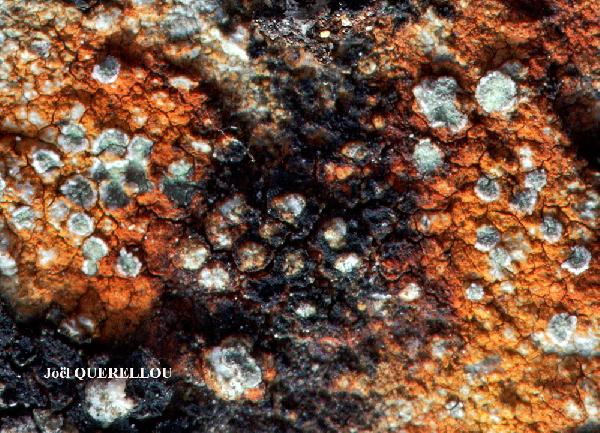
Joël Querellou - Source: http://www.lichensmaritimes.org/index.php?task=fiche&lichen=419&lang=en
France, Lac Drennec
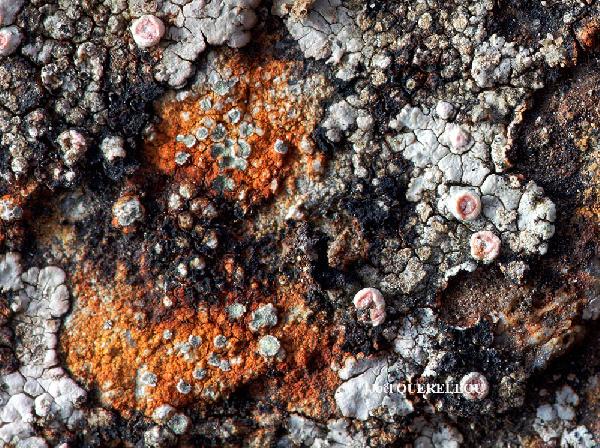
Joël Querellou - Source: http://www.lichensmaritimes.org/index.php?task=fiche&lichen=419&lang=en
France, Lac Drennec
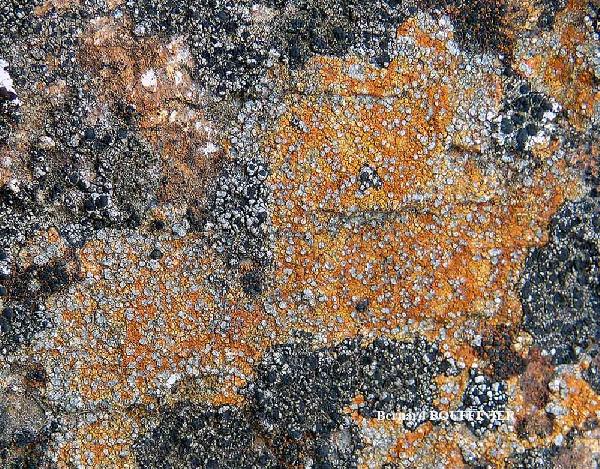
Bernard Bouffinier - Source: http://www.lichensmaritimes.org/index.php?task=fiche&lichen=419&lang=en
France, Commana
Sur schiste ardoisier riche en fer
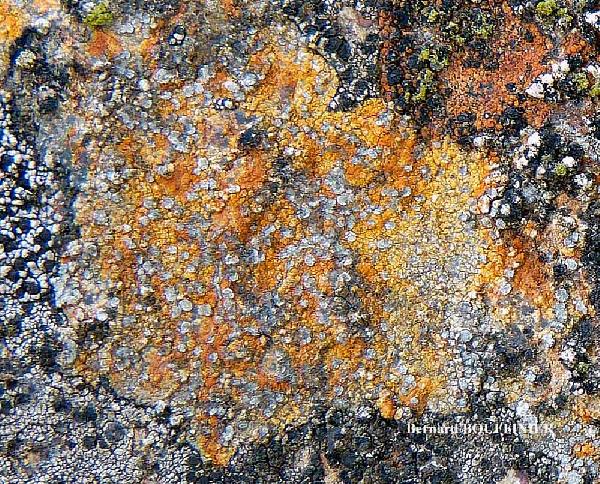
Bernard Bouffinier - Source: http://www.lichensmaritimes.org/index.php?task=fiche&lichen=419&lang=en
France, Commana
Sur schiste ardoisier riche en fer
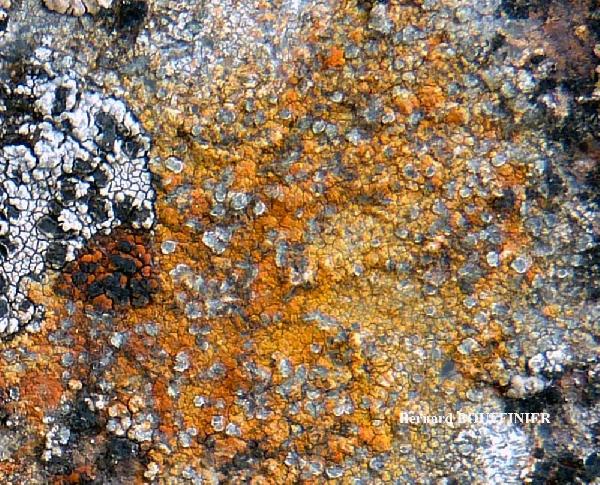
Bernard Bouffinier - Source: http://www.lichensmaritimes.org/index.php?task=fiche&lichen=419&lang=en
France, Commana
Sur schiste ardoisier riche en fer
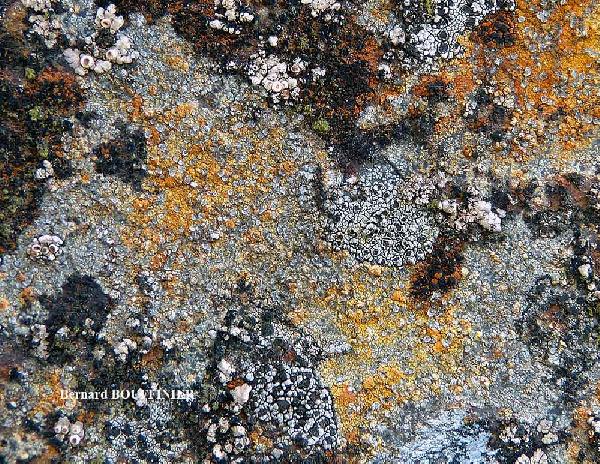
Bernard Bouffinier - Source: http://www.lichensmaritimes.org/index.php?task=fiche&lichen=419&lang=en
France, Commana
Sur schiste ardoisier riche en fer
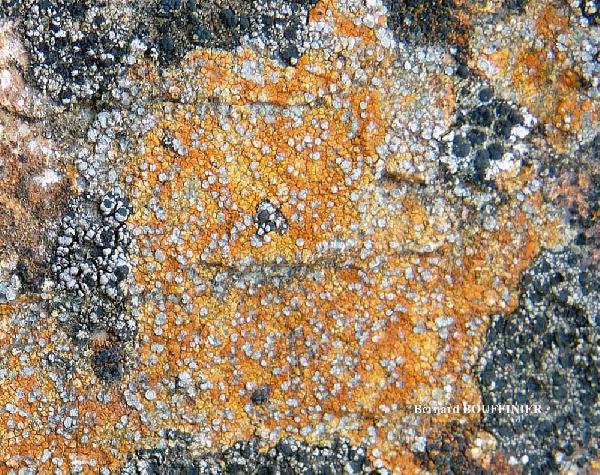
Bernard Bouffinier - Source: http://www.lichensmaritimes.org/index.php?task=fiche&lichen=419&lang=en
France, Commana
Sur schiste ardoisier riche en fer
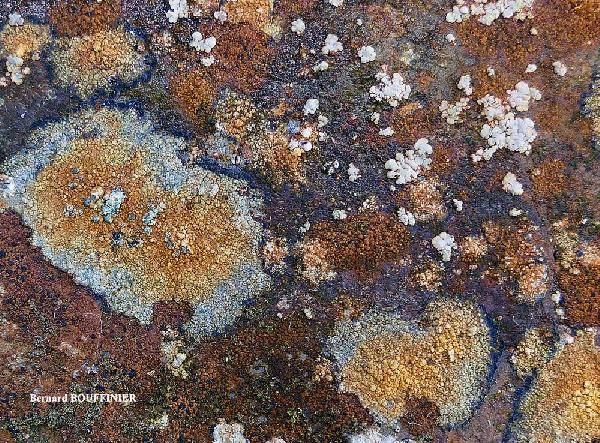
Bernard Bouffinier - Source: http://www.lichensmaritimes.org/index.php?task=fiche&lichen=419&lang=en
France, Commana
Sur schiste ardoisier riche en fer

Bernard Bouffinier - Source: http://www.lichensmaritimes.org/index.php?task=fiche&lichen=419&lang=en
France, Commana
Sur schiste ardoisier riche en fer
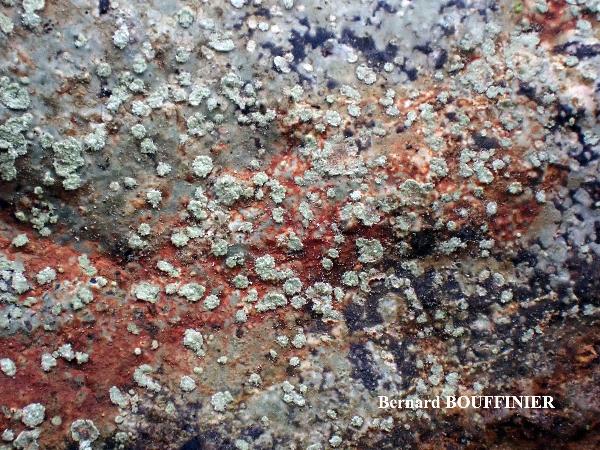
Bernard Bouffinier - Source: http://www.lichensmaritimes.org/index.php?task=fiche&lichen=419&lang=en
France, Cast
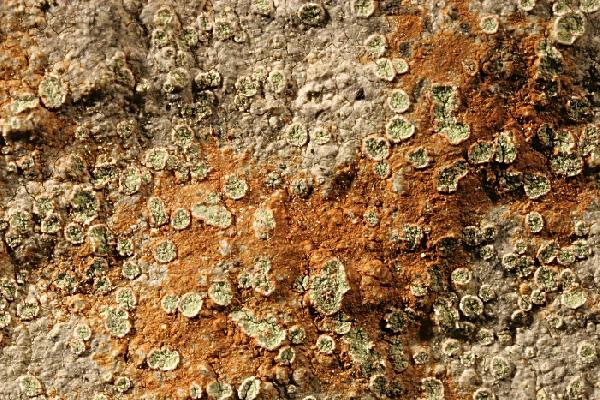
Ulrich Kirschbaum CC BY-SA 4.0 - Source: https://www.thm.de/lse/ulrich-kirschbaum/flechtenbilder
Central Europe: Germany. (Collected by Mattonet).


Felix Schumm - CC BY-SA 4.0
[11835], Germany: Niedersachsen, Kreis Uslar, Solling, auf Dachziegeln
einer forstlichen Lagerhütte, Eichenwald, (ca. 51°41' N, 9°31' E,
200 m ?), TK: 4323, Leg. H. G. Wagner, 07.08.2004, det. H. G. Wagner,
conf. F. Schumm. - Epithecium 10 μm; Hymenium hell, nicht
inspers,85-90 μm; Hypothecium braunschwarz, ca.110 μm; Aphithithecium
braunschwarz außen dunkler; Sporen keine gesehen; Paraphysen
1 μm, oben verzweigt; Mark und Sorale K+ gelb, C-, KC-, P+ orange


Felix Schumm - CC BY-SA 4.0
[11835], Germany: Niedersachsen, Kreis Uslar, Solling, auf Dachziegeln
einer forstlichen Lagerhütte, Eichenwald, (ca. 51°41' N, 9°31' E,
200 m ?), TK: 4323, Leg. H. G. Wagner, 07.08.2004, det. H. G. Wagner,
conf. F. Schumm. - Epithecium 10 μm; Hymenium hell, nicht
inspers,85-90 μm; Hypothecium braunschwarz, ca.110 μm; Aphithithecium
braunschwarz außen dunkler; Sporen keine gesehen; Paraphysen
1 μm, oben verzweigt; Mark und Sorale K+ gelb, C-, KC-, P+ orange


Felix Schumm - CC BY-SA 4.0
[11835], Germany: Niedersachsen, Kreis Uslar, Solling, auf Dachziegeln
einer forstlichen Lagerhütte, Eichenwald, (ca. 51°41' N, 9°31' E,
200 m ?), TK: 4323, Leg. H. G. Wagner, 07.08.2004, det. H. G. Wagner,
conf. F. Schumm. - Epithecium 10 μm; Hymenium hell, nicht
inspers,85-90 μm; Hypothecium braunschwarz, ca.110 μm; Aphithithecium
braunschwarz außen dunkler; Sporen keine gesehen; Paraphysen
1 μm, oben verzweigt; Mark und Sorale K+ gelb, C-, KC-, P+ orange
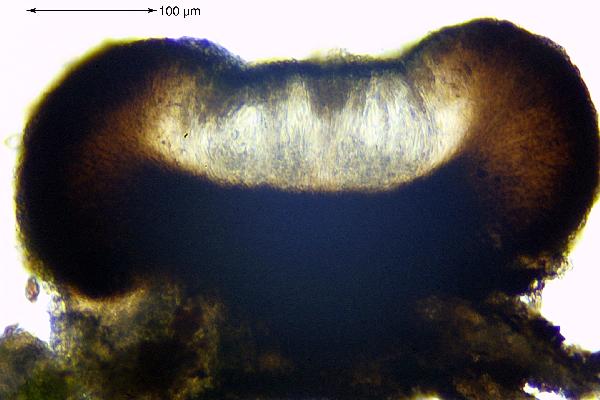

Felix Schumm - CC BY-SA 4.0
[11835], Germany: Niedersachsen, Kreis Uslar, Solling, auf Dachziegeln
einer forstlichen Lagerhütte, Eichenwald, (ca. 51°41' N, 9°31' E,
200 m ?), TK: 4323, Leg. H. G. Wagner, 07.08.2004, det. H. G. Wagner,
conf. F. Schumm. - Epithecium 10 μm; Hymenium hell, nicht
inspers,85-90 μm; Hypothecium braunschwarz, ca.110 μm; Aphithithecium
braunschwarz außen dunkler; Sporen keine gesehen; Paraphysen
1 μm, oben verzweigt; Mark und Sorale K+ gelb, C-, KC-, P+ orange
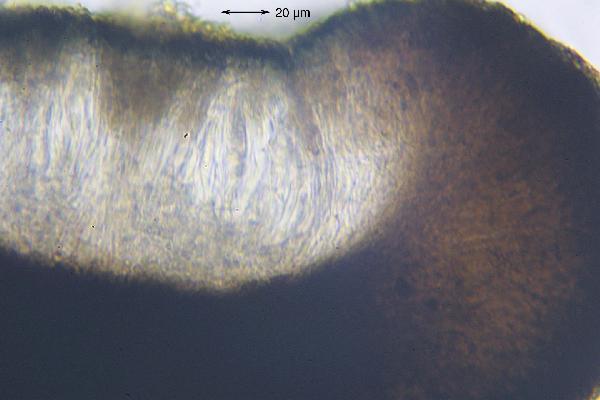

Felix Schumm - CC BY-SA 4.0
[11835], Germany: Niedersachsen, Kreis Uslar, Solling, auf Dachziegeln
einer forstlichen Lagerhütte, Eichenwald, (ca. 51°41' N, 9°31' E,
200 m ?), TK: 4323, Leg. H. G. Wagner, 07.08.2004, det. H. G. Wagner,
conf. F. Schumm. - Epithecium 10 μm; Hymenium hell, nicht
inspers,85-90 μm; Hypothecium braunschwarz, ca.110 μm; Aphithithecium
braunschwarz außen dunkler; Sporen keine gesehen; Paraphysen
1 μm, oben verzweigt; Mark und Sorale K+ gelb, C-, KC-, P+ orange
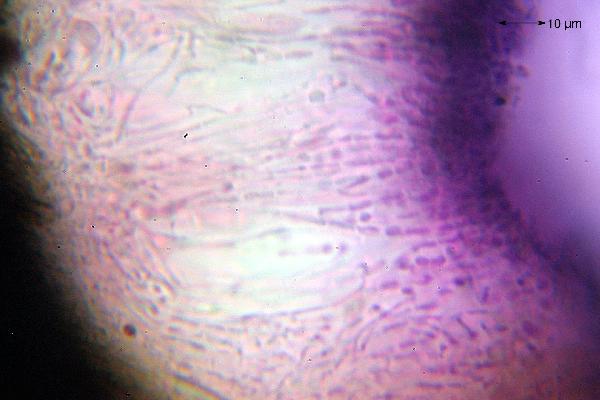

Felix Schumm - CC BY-SA 4.0
[11835], Germany: Niedersachsen, Kreis Uslar, Solling, auf Dachziegeln
einer forstlichen Lagerhütte, Eichenwald, (ca. 51°41' N, 9°31' E,
200 m ?), TK: 4323, Leg. H. G. Wagner, 07.08.2004, det. H. G. Wagner,
conf. F. Schumm. - Epithecium 10 μm; Hymenium hell, nicht
inspers,85-90 μm; Hypothecium braunschwarz, ca.110 μm; Aphithithecium
braunschwarz außen dunkler; Sporen keine gesehen; Paraphysen
1 μm, oben verzweigt; Mark und Sorale K+ gelb, C-, KC-, P+ orange
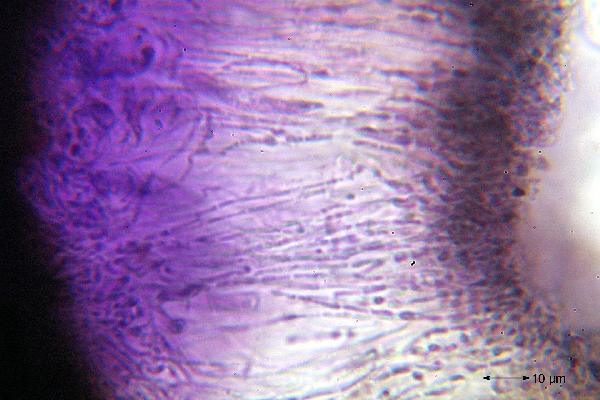

Felix Schumm - CC BY-SA 4.0
[11835], Germany: Niedersachsen, Kreis Uslar, Solling, auf Dachziegeln
einer forstlichen Lagerhütte, Eichenwald, (ca. 51°41' N, 9°31' E,
200 m ?), TK: 4323, Leg. H. G. Wagner, 07.08.2004, det. H. G. Wagner,
conf. F. Schumm. - Epithecium 10 μm; Hymenium hell, nicht
inspers,85-90 μm; Hypothecium braunschwarz, ca.110 μm; Aphithithecium
braunschwarz außen dunkler; Sporen keine gesehen; Paraphysen
1 μm, oben verzweigt; Mark und Sorale K+ gelb, C-, KC-, P+ orange
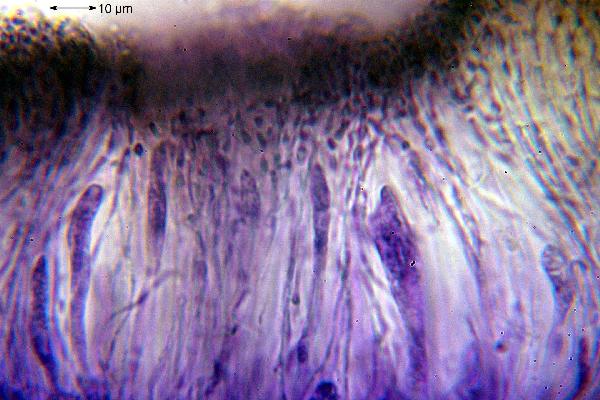

Felix Schumm - CC BY-SA 4.0
[11835], Germany: Niedersachsen, Kreis Uslar, Solling, auf Dachziegeln
einer forstlichen Lagerhütte, Eichenwald, (ca. 51°41' N, 9°31' E,
200 m ?), TK: 4323, Leg. H. G. Wagner, 07.08.2004, det. H. G. Wagner,
conf. F. Schumm. - Epithecium 10 μm; Hymenium hell, nicht
inspers,85-90 μm; Hypothecium braunschwarz, ca.110 μm; Aphithithecium
braunschwarz außen dunkler; Sporen keine gesehen; Paraphysen
1 μm, oben verzweigt; Mark und Sorale K+ gelb, C-, KC-, P+ orange
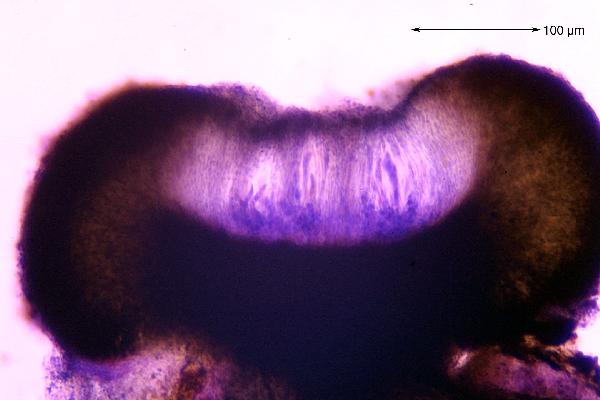

Felix Schumm - CC BY-SA 4.0
[11835], Germany: Niedersachsen, Kreis Uslar, Solling, auf Dachziegeln
einer forstlichen Lagerhütte, Eichenwald, (ca. 51°41' N, 9°31' E,
200 m ?), TK: 4323, Leg. H. G. Wagner, 07.08.2004, det. H. G. Wagner,
conf. F. Schumm. - Epithecium 10 μm; Hymenium hell, nicht
inspers,85-90 μm; Hypothecium braunschwarz, ca.110 μm; Aphithithecium
braunschwarz außen dunkler; Sporen keine gesehen; Paraphysen
1 μm, oben verzweigt; Mark und Sorale K+ gelb, C-, KC-, P+ orange
Growth form: Crustose
Substrata: rocks
Photobiont: green algae other than Trentepohlia
Reproductive strategy: mainly asexual, by soredia, or soredia-like structures (e.g. blastidia)
Most common in areas with a humid-warm climate (e.g. most of Tyrrenian Italy)
Commonnes-rarity: (info)
Alpine belt: absent
Subalpine belt: extremely rare
Oromediterranean belt: absent
Montane belt: very rare
Submediterranean belt: absent
Padanian area: absent
Humid submediterranean belt: absent
Humid mediterranean belt: absent
Dry mediterranean belt: absent

Predictive model

Bernard Bouffinier - Source: http://www.lichensmaritimes.org/index.php?task=fiche&lichen=419&lang=en
France, Cast

Joël Querellou - Source: http://www.lichensmaritimes.org/index.php?task=fiche&lichen=419&lang=en
France, Lac Drennec

Joël Querellou - Source: http://www.lichensmaritimes.org/index.php?task=fiche&lichen=419&lang=en
France, Lac Drennec

Bernard Bouffinier - Source: http://www.lichensmaritimes.org/index.php?task=fiche&lichen=419&lang=en
France, Commana
Sur schiste ardoisier riche en fer

Bernard Bouffinier - Source: http://www.lichensmaritimes.org/index.php?task=fiche&lichen=419&lang=en
France, Commana
Sur schiste ardoisier riche en fer

Bernard Bouffinier - Source: http://www.lichensmaritimes.org/index.php?task=fiche&lichen=419&lang=en
France, Commana
Sur schiste ardoisier riche en fer

Bernard Bouffinier - Source: http://www.lichensmaritimes.org/index.php?task=fiche&lichen=419&lang=en
France, Commana
Sur schiste ardoisier riche en fer

Bernard Bouffinier - Source: http://www.lichensmaritimes.org/index.php?task=fiche&lichen=419&lang=en
France, Commana
Sur schiste ardoisier riche en fer

Bernard Bouffinier - Source: http://www.lichensmaritimes.org/index.php?task=fiche&lichen=419&lang=en
France, Commana
Sur schiste ardoisier riche en fer

Bernard Bouffinier - Source: http://www.lichensmaritimes.org/index.php?task=fiche&lichen=419&lang=en
France, Commana
Sur schiste ardoisier riche en fer

Bernard Bouffinier - Source: http://www.lichensmaritimes.org/index.php?task=fiche&lichen=419&lang=en
France, Cast

Ulrich Kirschbaum CC BY-SA 4.0 - Source: https://www.thm.de/lse/ulrich-kirschbaum/flechtenbilder
Central Europe: Germany. (Collected by Mattonet).


Felix Schumm - CC BY-SA 4.0
[11835], Germany: Niedersachsen, Kreis Uslar, Solling, auf Dachziegeln einer forstlichen Lagerhütte, Eichenwald, (ca. 51°41' N, 9°31' E, 200 m ?), TK: 4323, Leg. H. G. Wagner, 07.08.2004, det. H. G. Wagner, conf. F. Schumm. - Epithecium 10 μm; Hymenium hell, nicht inspers,85-90 μm; Hypothecium braunschwarz, ca.110 μm; Aphithithecium braunschwarz außen dunkler; Sporen keine gesehen; Paraphysen 1 μm, oben verzweigt; Mark und Sorale K+ gelb, C-, KC-, P+ orange


Felix Schumm - CC BY-SA 4.0
[11835], Germany: Niedersachsen, Kreis Uslar, Solling, auf Dachziegeln einer forstlichen Lagerhütte, Eichenwald, (ca. 51°41' N, 9°31' E, 200 m ?), TK: 4323, Leg. H. G. Wagner, 07.08.2004, det. H. G. Wagner, conf. F. Schumm. - Epithecium 10 μm; Hymenium hell, nicht inspers,85-90 μm; Hypothecium braunschwarz, ca.110 μm; Aphithithecium braunschwarz außen dunkler; Sporen keine gesehen; Paraphysen 1 μm, oben verzweigt; Mark und Sorale K+ gelb, C-, KC-, P+ orange


Felix Schumm - CC BY-SA 4.0
[11835], Germany: Niedersachsen, Kreis Uslar, Solling, auf Dachziegeln einer forstlichen Lagerhütte, Eichenwald, (ca. 51°41' N, 9°31' E, 200 m ?), TK: 4323, Leg. H. G. Wagner, 07.08.2004, det. H. G. Wagner, conf. F. Schumm. - Epithecium 10 μm; Hymenium hell, nicht inspers,85-90 μm; Hypothecium braunschwarz, ca.110 μm; Aphithithecium braunschwarz außen dunkler; Sporen keine gesehen; Paraphysen 1 μm, oben verzweigt; Mark und Sorale K+ gelb, C-, KC-, P+ orange


Felix Schumm - CC BY-SA 4.0
[11835], Germany: Niedersachsen, Kreis Uslar, Solling, auf Dachziegeln einer forstlichen Lagerhütte, Eichenwald, (ca. 51°41' N, 9°31' E, 200 m ?), TK: 4323, Leg. H. G. Wagner, 07.08.2004, det. H. G. Wagner, conf. F. Schumm. - Epithecium 10 μm; Hymenium hell, nicht inspers,85-90 μm; Hypothecium braunschwarz, ca.110 μm; Aphithithecium braunschwarz außen dunkler; Sporen keine gesehen; Paraphysen 1 μm, oben verzweigt; Mark und Sorale K+ gelb, C-, KC-, P+ orange


Felix Schumm - CC BY-SA 4.0
[11835], Germany: Niedersachsen, Kreis Uslar, Solling, auf Dachziegeln einer forstlichen Lagerhütte, Eichenwald, (ca. 51°41' N, 9°31' E, 200 m ?), TK: 4323, Leg. H. G. Wagner, 07.08.2004, det. H. G. Wagner, conf. F. Schumm. - Epithecium 10 μm; Hymenium hell, nicht inspers,85-90 μm; Hypothecium braunschwarz, ca.110 μm; Aphithithecium braunschwarz außen dunkler; Sporen keine gesehen; Paraphysen 1 μm, oben verzweigt; Mark und Sorale K+ gelb, C-, KC-, P+ orange


Felix Schumm - CC BY-SA 4.0
[11835], Germany: Niedersachsen, Kreis Uslar, Solling, auf Dachziegeln einer forstlichen Lagerhütte, Eichenwald, (ca. 51°41' N, 9°31' E, 200 m ?), TK: 4323, Leg. H. G. Wagner, 07.08.2004, det. H. G. Wagner, conf. F. Schumm. - Epithecium 10 μm; Hymenium hell, nicht inspers,85-90 μm; Hypothecium braunschwarz, ca.110 μm; Aphithithecium braunschwarz außen dunkler; Sporen keine gesehen; Paraphysen 1 μm, oben verzweigt; Mark und Sorale K+ gelb, C-, KC-, P+ orange


Felix Schumm - CC BY-SA 4.0
[11835], Germany: Niedersachsen, Kreis Uslar, Solling, auf Dachziegeln einer forstlichen Lagerhütte, Eichenwald, (ca. 51°41' N, 9°31' E, 200 m ?), TK: 4323, Leg. H. G. Wagner, 07.08.2004, det. H. G. Wagner, conf. F. Schumm. - Epithecium 10 μm; Hymenium hell, nicht inspers,85-90 μm; Hypothecium braunschwarz, ca.110 μm; Aphithithecium braunschwarz außen dunkler; Sporen keine gesehen; Paraphysen 1 μm, oben verzweigt; Mark und Sorale K+ gelb, C-, KC-, P+ orange


Felix Schumm - CC BY-SA 4.0
[11835], Germany: Niedersachsen, Kreis Uslar, Solling, auf Dachziegeln einer forstlichen Lagerhütte, Eichenwald, (ca. 51°41' N, 9°31' E, 200 m ?), TK: 4323, Leg. H. G. Wagner, 07.08.2004, det. H. G. Wagner, conf. F. Schumm. - Epithecium 10 μm; Hymenium hell, nicht inspers,85-90 μm; Hypothecium braunschwarz, ca.110 μm; Aphithithecium braunschwarz außen dunkler; Sporen keine gesehen; Paraphysen 1 μm, oben verzweigt; Mark und Sorale K+ gelb, C-, KC-, P+ orange


 INDEX FUNGORUM
INDEX FUNGORUM
 GBIF
GBIF
 DOLICHENS
DOLICHENS
